







































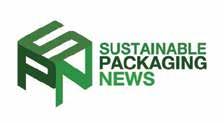


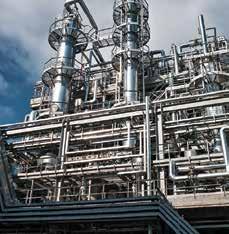

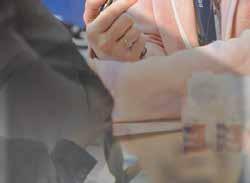




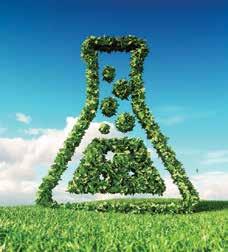
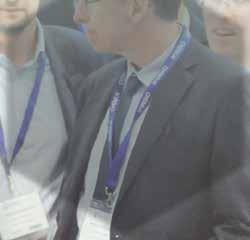
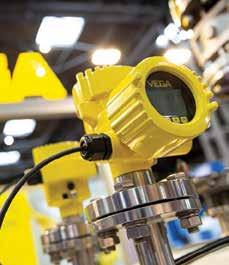

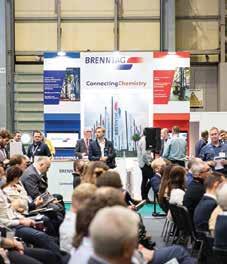
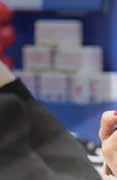




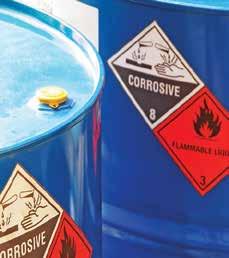

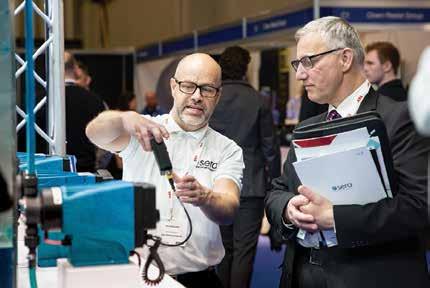










































































I hope this finds everyone keeping well and staying safe!
In our fast-changing world, it is not always easy to keep pace with the day -to-day challenges that we must face. Not least, the fallout from the dreadful and barbaric war in Ukraine, with all its ramifications affecting global inflation levels and supply chain uncertainty.
However, I know that I have said this before, but from the view I see from my desk, it never fails to surprise me, just how resilient and resourceful packaging companies are in times of such hardship. Everyone here at SPN is both encouraged and pleased to see this, and the fact that it has not deterred companies from taking even greater strides in their efforts to achieve their sustainability goals, is quite amazing. So fortunately for us all, the Packaging industry is continuing to succeed more than most in effecting the changes that must take place, in order for us to tackle climate change and create a truly circular economy for the world we live in.
Today, with interpack 2023 upon us, there are countless examples of fresh, innovative thinking, as well as cutting-edge technology being showcased. In fact, some of the most exciting and gamechanging advances are featured here in this special SPN interpack issue. For example, Unilever’s Hellmann’s sauces have designed a label that visibly changes completely, to show whether a product remains fresh. This alone can transform the world’s levels of food waste. Furthermore, there is also a most helpful global overview from KPMG, on how best to deal with - and overcome, the latest supply chain challenges. Naturally, there is also a lot of focus on interpack, with our broad coverage of a wide range of companies and their innovative products.
So, once again, I thank you all so much for your valued editorial contributions and for your support in helping us to achieve our vitally important sustainability goals. In the meantime, enjoy interpack and all it has to offer, whilst maintaining your infectious positivity!
 Philip Yorke ( Editor )
Philip Yorke ( Editor )











Linda Ellet, a partner at KPMG, offers some very helpful advice to packaging companies struggling with maintaining their supply chain efficiency. In cooling supply chain hot-spots, you must be clear about what you expect from your suppliers and how you can help. Therefore, you must prioritise and understand your hotspots as well as communicate, engage and encourage collaboration. Furthermore, don’t be overwhelmed by the abundance of data.
Although only large UK companies are required to report on their energy usage and carbon emissions, the effects trickle right down the value chain. A staggering 80% of a business’s emissions are produced indirectly by suppliers yet contribute to their overall carbon footprint. If big businesses are to realise their net-zero ambitions, then supply chain decarbonisation is critical.
The sustainability strategy for FTSE-250 company Britvic plc is ‘Healthier People, Healthier Planet’. It underlines the company’s commitment to making the world a better place. Britvic plc was the first soft drinks company in the UK to commit to the 1.5 degree pathway and has an ambitious target to reduce its Scope 1 and 2 emissions by 50% and Scope 3 carbon emissions by 35% by 2025. It identifies its material issues as healthier consumer choices, responsible packaging, decarbonisation, water stewardship and biodiversity.

The Greenhouse Gas (GHG) Protocol requires companies to understand, measure and report on emissions and to focus their efforts on the greatest reduction opportunities. Scope 1 and 2 emissions are owned or controlled directly by the company itself. Scope 3 emissions are hardest to identify as they are produced indirectly by suppliers and businesses up and down the value chain.
Sarah Webster, director of sustainable business at Britvic plc, says: “If we don’t have water, there are no soft drinks. If there are no bees, there is no Robinsons fruit squash.” Sarah joined Lina Hilwani, director within KPMG’s Sustainable Supply Chain team, in a refreshingly frank exchange on how businesses and suppliers can grapple with Scope 3 emissions.

To engage with the supply chain and support their efforts to reduce emissions, Lina believes it starts with addressing the “what, how and why” of decarbonisation.
• Be clear about what you are asking suppliers to do – perhaps a change in raw materials or an alternative delivery route – and include specific steps to improvement.
• Invest time in thinking about how your suppliers will deliver the changes you want. It might involve co-investment in new technology, or simply giving them more knowledge that will result in better data and, therefore, better traceability and reporting.
• Help suppliers to understand why you’re doing it and what’s in it for them. Demonstrate how value from decarbonisation of the supply chain adds resilience to your relationship with your supplier and, in turn, to their relationships with other customers.
Be clear about what you expect from your suppliers and how you can help. Prioritise and understand your hotspots. Communicate, engage and encourage collaboration. In addition, don’t be overwhelmed by the abundance of data.
There is no escaping data in Scope 3. Yet non-financial data needs to be treated with the same rigour as financial data. Data helps businesses to understand their hotspots, to size the opportunity and to break it down into its component parts. It helps with targeting investment, effort and resources where they are most needed. Data is the means to track progress against targets. Britvic plc, in its initial assessments, identified that 80% of its material impacts are down to around 20% of its material suppliers.
Taking an 80:20 approach to Scope 3 makes the exercise “more manageable and less overwhelming, than going for nth-degree accuracy” explains Sarah. For Lina, it’s about “being brave enough to estimate without having to dissect forensically every number that underlies every assumption.”
- Lina Hilwani, director, KPMG Sustainable Supply Chain. From an Article Posted on 28 March 2023
“ Scope 3 emissions are hardest to identify as they are produced indirectly ”
Making the right packaging choices is never easy, however, it can provide an opportunity for businesses to achieve greater sustainability. Often, sustainability claims can make that decision difficult and confusing. Clearly, businesses want to make well-informed decisions - which is why PakTech has created a valuable, easy-to-read checklist to ensure that companies can get it right first time. The alternative can prove to be expensive! Here the company sets out its case for the benefit of our readers…
To evaluate the sustainability performance of packaging, the environmental impact of its manufacturing process must be examined first. Make sure to address the following points with the packaging provider in consideration:
• Greenhouse gas (GHG) emissions
• Ozone depletion
• Water resource depletion
• Water contamination
• Energy source
• Energy consumption
Ask the packaging provider if they have the data related to the above aspects – it will show you how serious they are to their sustainability commitments while allowing you to see how their solutions compare with alternatives.


Businesses looking for sustainable packaging must also consider its level of circularity. According to the Ellen MacArthur Foundation, the circular economy is a “systems solution framework that tackles global challenges like climate change, biodiversity loss, waste, and pollution.” Designing packaging in a way that is consistent with the circular economy enables us to transition from a “use and waste” linear model to a circular model.
Ask the following questions when gauging the level of circularity of the packaging in consideration:
• Does it use recycled content? If so, how much?
• Is it reusable to elongate its current useful life?
• Is it recyclable?
• Is it infinitely recyclable to ensure a waste-free future?

You can be rest assured that the packaging solution shows high alignment with circular economy principles if it checks all the above requirements.
Perhaps you’re browsing through packaging catalogues, and you want to assess if the packaging in question meets your expectations at a glance. Evaluate whether the packaging embodies sustainable design:

• Does the design ensure efficient product to packaging ratio?
• Is the material durable to reduce waste generation?
• Is the design minimalist in format to minimise resource use?
• Does it use lightweight material to improve transportation and energy efficiency?
If the packaging under consideration does not pass this initial test, you may want to consider an alternative.
A Resounding Yes! At PakTech, we are proud of our holistic approach to the environment:
• By manufacturing with 100% recycled HDPE, PakTech handles generate 78% less greenhouse gases, uses 90% less energy and uses 0 virgin petroleum.
• PakTech handles are 100% recycled, reusable and recyclable to be fully aligned with the circular economy.
• 80% of energy used at PakTech’s production facility comes from 80% carbon-free hydroelectric energy.
• Minimalist, lightweight and durable, PakTech handles are designed to eliminate waste generation while maximising transportation, energy and resource efficiency.
With PakTech, you will be rest assured that your business is choosing the best in class when it comes to the most sustainable secondary packaging solutions.
At SPN, we hope that PakTech’s well - considered approach provides helpful guide and offers answers to procurement managers that may be wrestling with their many complex decisions involved in relation to optimising their sustainable packaging portfolios!
“ At PakTech, we are proud of our holistic approach to the environment ”
SPN Invited Syntegon for their current assessment of the global packaging market and how their drive towards greater sustainability and the Circular Economy were being endorsed by their innovation and the on-going optimisation of its advanced technology equipment.

“Food producing companies across Europe must therefore invest in innovative technologies that protect people and the environment, while still maintaining competitiveness across different industries”
Syntegon continued: “Food companies are facing many challenges due to fluctuating raw material prices, changing regulations, and demanding consumers. One of their major hurdles is to achieve sustainability goals, while acting in an economically and ecologically viable way. Food producers, therefore, need the support from technology experts to flexibly and efficiently meet market demands. Syntegon is ready and able to take on that role.
Plastic has long been considered the packaging material of choice across most industries. These times are slowly, but steadily, coming to an end. For instance, in the EU, several countries are aiming for a significant reduction in plastic, each with a different strategy. France is taking a particularly bold stance: by 2040, single-use packaging is to disappear from French consumers’ lives. The phased plan includes plasticbased products, from disposable cups to register receipts.
France is not alone in this endeavour, however; countries such as Belgium and Spain are following suit and even going beyond the EU regulations, which state all plastic packaging on the European market must be recyclable or reusable by 2030. In Spain, for example, plastic beverage or food containers may no longer be distributed free of charge as of January 1, 2023, provided they are intended for direct food consumption. If this packaging is still used, consumers are charged a fee.
By doing this, legislation hopes to reduce sales of these products by 50 percent by 2026 and 70 percent by 2030. In 2020, the EU saw the introduction of the so-called “plastics tax”. It includes a levy of 0.80 euros per kilogram of nonrecycled plastic packaging waste generated in each respective member states. Germany alone had to pay 1.3 billion euros in tax money to the EU in 2021 due to this. The current German government wants to hold manufacturers and distributors of plastic packaging more accountable. According to its coalition agreement, these companies are intended to pay the EU plastics tax in the long term.

Regulatory pressure has the food industry turning towards alternative packaging solutions, with paper as the new packaging material of choice. In the public perception, paper is seen as more environmentally friendly. Unlike plastic, it also decomposes faster and is easy to recycle. However, while paper accounts for a considerable share of the overall packaging solution, especially with liquid or viscous foods, it is not the only used material. Current paper packaging solutions are composite materials, since they need a plastic barrier for tightness and product protection.
Germany has again defined strict rules: paper-based packaging material may not exceed a plastic content of five percent. This ensures the recyclability of paper-based packaging so that it can enter the established value streams like conventional paper – provided it is not too heavily contaminated after use. As an alternative to paper-based packaging, innovative solutions made of mono-materials are available to food companies: films, cups, and blanks made of polyethylene (PE) or polypropylene (PP) offer the same protection as classic composite materials – with the advantage of significantly higher recyclability.
Food producers have plenty of options to ensure an ecological production that complies with regulations. The challenge consists in aligning complex legal requirements with the demands of their own products – and in acting both ecologically and economically in the process. This affects both their own interests as well as their consumers’ for besides food quality and innovative recipes, ecological packaging solutions and manufacturing processes influence purchasing decisions significantly.
Producers must therefore be flexible in their choice of packaging formats and materials. “This enables them to implement solutions that meet the requirements of the respective products and consumers without disregarding company-specific sustainability goals,” says Ilona Junker, Project Manager Sustainable Solutions at Syntegon.
According to Ilona Junker, food manufacturers must consider the packaging needs of each product to achieve this balance. Ecological and quality aspects play an equally important role, especially in the food industry where hygienic considerations are decisive. Dairy and delicatessen products such as yogurt, sour cream, spreads, deli salads, dips, and sauces often require continuous cooling. Food brands usually fill these products under clean or ultra-clean conditions. The strict hygiene requirements for filling drinkable and baby foods, on the other hand, demand aseptic processing with even higher sterilization rates. This retains the products’ shelf life for a long time even without refrigeration or additional additives and prevents product loss.
“Producers always face the challenge of investing in equipment that meets the right hygiene requirements – in addition to the high expectations regarding product sustainability,” says Ilona Junker. Syntegon works with a holistic approach that covers both packaging and machine technology. The company advises food manufacturers on paper or mono-material usage and offers an equipment portfolio for all hygiene classes. “Our technology ensures sustainable and safe products in the long term – and future-proof production.”

Flexible and efficient solutions are in high demand among food producers and technology providers alike. State-of-theart equipment should enable them to take ecological and economical aspects into account and to reconcile social needs and product protection. To this effect, the equipment must be able to process different products and packaging materials safely and operate in an energy-efficient way. But what exactly does that mean?
Take the processing of liquid foods. Here, different hygiene classes have different effects on energy consumption during production and storage. The storage of food produced under clean conditions requires more energy than aseptic production, which does away with cold chains. Cups or other packaging are not pre-sterilized during clean manufacturing. As a result, the packaged foods have a shorter shelf life and require continuous cooling. With aseptic and ultra-clean filling, on the other hand, the packaged products can be stored without additional refrigeration due to the previous packaging sterilisation.
“Our portfolio offers manufacturers the required flexibility to process products according to their respective quality and sustainability goals,” says Ilona Junker. While pre-sterilization may make sense and be feasible for company A, company B may opt for clean filling due to product characteristics or budget constraints – for example, if it mainly has products with a short shelf life in its portfolio. The ideal solution must be determined case by case. “Each package or product has an individual carbon footprint. Knowing this in advance can help companies find the right machine and manage their own sustainability measures in a more targeted manner,” Ilona Junker explains.
In line with its holistic approach, Syntegon offers its customers consulting services. With its software-based methodology certified by TÜV Rheinland, companies in the pharmaceutical and food industries receive full transparency regarding the carbon footprint of their Syntegon machines. The calculation method developed by Syntegon can be carried out on request, covering parameters such as electricity, compressed air, media, and packaging materials. Moreover, the flexible methodology allows to examine both packaging and processing equipment by linking the parameters to the respective carbon emissions. This way, Syntegon’s calculation can help to holistically determine resource consumption for each customer.

Food producers also benefit from modern equipment that can be flexibly expanded to enable future-proof production. Modular systems allow them to efficiently adapt production to specific applications – for example, if regulations urge companies to process paper instead of plastic or if they must achieve higher energy savings. The modular LFS from Syntegon, for example, can be equipped with up to three servo-controlled dosing systems, filling 7,000 to over 20,000 cups per hour.
Different product viscosities can be filled with high precision and low product loss. In case of product changes, operators only need to replace the nozzles of the dosing stations in a few simple steps. A mobile cleaning bar ensures fully automated intermediate rinsing and cleaning of the dosing unit.
“ Our portfolio offers manufacturers the required flexibility to process products according to their respective quality and sustainability goals ”
“With our modular approach, we support companies that have so far shied away from investments due to volatile market conditions. Since our machines can be converted or retrofitted at any time, they offer an ideal basis for production, especially in times of increasing efficiency requirements and high sustainability standards,” Ilona Junker emphasises.
Thanks to various retrofit options, existing machines can also be adapted to meet the changing standards of sustainable and quality-oriented production, for example with special forming shoulders for paper packaging. Manufacturing companies remain flexible in their choice of packaging materials.

Depending on market and legal needs, modular systems can be used to process paper, PP, or PET mono-materials. “This wealth of options helps companies respond to current trends in a product-specific way without having to commit to a specific solution from the outset. As a result, they remain competitive in the current production environment,” Ilona Junker explains. Manufacturing companies can count on Syntegon to navigate the alternatives. “Since we have a holistic approach to sustainability and production, we support companies both as technology experts and as consultants.” In addition to its CO2 analysis, Syntegon also offers legal advice. “We see it as our duty to know current regulations and global sustainability trends and to advise customers accordingly – especially with regard to the right machine solution,” says Ilona Junker.
What regulations will the food industry face across the globe? How must manufacturers adapt their systems to remain competitive? Syntegon’s experts provide the answers to these questions. “Decision-makers of manufacturing companies rely on these consulting services and our support.”

Within the scope of its holistic approach, Syntegon also has an eye on its own activities as a sustainable equipment manufacturer – with ambitious goals for the coming years. By 2025, the company aims to reduce its worldwide carbon emissions by 25 percent and even by 50 percent five years from there. In addition to the calculations for its own machines and the derived optimisation potential, the company also relies on professional cooperations. With the support from packaging material suppliers and academia, Syntegon seeks to harmonise sustainable action and efficient production – for itself and for its customers. In other words, in a fully sustainable way!
SPN is pleased to publish extracts from an recent paper posted in January this year by Emily Newton, a journalist who is no stranger to our SPN shores!

Why is Digitalisation Increasingly Important for the Packaging Industry? Packaging industry technology has become more advanced over the years. Such progress is necessary for helping established brands and industry professionals stay competitive and meet changing needs. Pursuing a digital transformation can also set some companies apart from others, assisting digital-first businesses to remain profitable. With so many enterprises ramping up digitalisation efforts, some people argue the packaging industry must follow suit to stay caught up.

Working as a packaging line employee can be physically strenuous due to the repetitive motions required. Decisionmakers at Orora Fresh Packaging Solutions invested in a robotic cell for its Canadian headquarters. The machine fed corrugated cardboard sheets into equipment that formed boxes from the material.
This change cut injury rates while reducing the number of employees needed to run the machinery. Employees could only put 10-15 cardboard sheets into the machine at once before the company invested in automation. This limitation meant they had to repeat the associated movements throughout the workday, increasing the chances of strain. The situation was even worse, considering it sometimes became very hot in the plant. These challenges often made it difficult to retain additional staff to accommodate seasonal peaks.
The company’s human resources manager also indicated some of its older packaging machines were particularly problematic in causing injuries when people reached up to load them. Since implementing the robotic solution, the company has achieved a seven-person decrease in the number of individuals needed to run its five box machines. However, it did this without eliminating any full-time positions at the plant. The automated elements of the technology updates also reduce the amount of scrap material produced while slashing the risk of trip and fall incidents. This example shows how packaging industry technology can have far-reaching effects.
Elsewhere, Amazon has a robotic work cell called Cardinal that uses computer vision and artificial intelligence to select, lift and transfer individual packages so they get to the right areas of the facility for further processing. It is testing a Cardinal prototype that can lift up to 50 lb. The company hopes to deploy it in fulfilment centres soon.
Today’s business representatives increasingly recognize the worth of custom packaging. That might mean having boxes designed to welcome newly hired employees, complete with a company’s logo and colours. A university might appeal to parents who are missing their college-aged kids by selling custom care packages with a recipient’s name, a personalized message and the image of the institution’s mascot.
Digital transformation supports those offerings by streamlining and automating the necessary package modifications. Colgate-Palmolive recently ran a trial where people could get customised toothpaste after taking an online quiz. The questions aimed to learn people’s goals, whether they wanted whiter smiles, fresher breath or had something else in mind. Besides choosing the toothpaste’s colour and flavour, people could also customize how the package looked. The relevant packaging industry technology delivered products to buyers in as few as five business days.

Custom packaging also boosts brand recognition among customers. Imagine if a person arrives home after a busy day to find a beautifully branded package waiting on their doorstep. That experience can make the recipient feel instantly excited about enjoying what’s inside. The design may also include social media information that encourages people to share pictures and opinions of their purchases. Another benefit of customized packaging is an eye-catching design could encourage people to reuse the container. Personal care brand Rituals uses custom packaging with nature designs and inspiring quotes. It also includes easy-open features to reduce frustration and promote joy during the unboxing experience.
The increase in digitisation means people could create customized packaging by simply indicating a few preferences within packaging software or an online interface. That ease of production tends to shorten turnaround times, making nongeneric packaging more easily fit into a company’s workflow without causing delays.
Digital technology used in the packaging sector is also instrumental in reducing machine outages that could otherwise be prohibitively disruptive. That often happens with Industrial Internet of Things (IIoT) sensors that collect machine health data. The goal is to provide operators with valuable data about potential problems before those issues cause outages.
The examples here show how digital upgrades can significantly improve packaging companies’ operations and expand their offerings to existing or potential customers. However, the best way to integrate packaging industry technology into workflows depends on a business’ current pain points and goals.
Leaders must also clarify how much they’ll spend on such improvements and what they’ll do to track progress. Examining a packaging facility’s layout is also necessary if the digitalization strategy involves investing in new machinery. Figuring out where to put the equipment before purchasing it emphasizes safety and productivity.
Clarifying the answers to questions like these will help executives make the most-informed decisions about when, why, and how to invest in packaging technology. Only then will they have the best chances of getting satisfying and profitable returns on investment.
“ Digital technology is also instrumental in reducing machine outages that could otherwise be prohibitively disruptive ”
“ Colgate-Palmolive recently ran a trial where people could get customised toothpaste after taking an online quiz ”

The EU has announced updates to regulations to comply with the Fit for 55 package. The plan is to halve its emissions by at least 55% by 2030 compared to 1990 levels and reach climate neutrality in 2050. The latest updates cover transport, effort sharing, land use and forestry sector, market stability reserve and the future gas and hydrogen market.
Presented by the European Commission in July 2021, the Fit for 55 package will enable the EU to reduce its net greenhouse gas (GHG) emissions by at least 55% by 2030 compared to 1990 levels and achieve climate neutrality in 2050. The EU has announced updates on CO2 emissions for new cars and vans, charging and fuelling stations for alternative fuels, effort sharing, land use and forestry sector, market stability reserve and the Member States’ position on the future gas and hydrogen market.
The European Council has adopted a regulation setting stricter CO2 emission performance standards for new cars and vans, revising rules last amended in 2019. The aim is to reduce emissions from road transport, which accounts for 71.7% of the transport sector’s footprint, which in turn is responsible for about a quarter of the bloc’s total CO2 emissions.
The proposal is also intended to push the automotive industry to shift towards zero-emission mobility while ensuring continued innovation in the industry.
The new targets are 55% CO2 emission reductions for new cars and 50% for new vans from 2030 to 2034 compared to 2021 levels; and 100% CO2 emission reductions for both new cars and vans from 2035. Progress will be reviewed in 2026, taking into account technological developments, including with regard to plug-in hybrid technologies and the importance of a viable and socially equitable transition towards zero emissions.
A regulatory incentive mechanism for zero- and low-emission vehicles will be in place from 2025 until the end of 2029. As part of this mechanism, if a manufacturer meets certain benchmarks for the sales of zero- and low-emission vehicles it can be rewarded with less strict CO2 targets. The benchmark is set at 25% for cars and 17% for vans.
The regulation contains a reference to e-fuels, whereby following a consultation with stakeholders, the Commission plans to make a proposal for registering vehicles running exclusively on CO2-neutral fuels after 2030.
When it comes to corrugated board and sustainable food packaging Flutepac’s Microflute corrugated packaging is music to your ears. Thanks to its robust construction, corrugated board has become the product of choice for a diverse range of packaging applications, however, one sector of industry that you rarely associate with corrugated packaging is the food industry – that is until now!
Roger Thompson, head of Innovation & Sustainability at Cepac told SPN, “If you look specifically at microflute corrugated packaging, it’s a really thin material that is similar in density to solidboard or folding carton-board, but it offers even greater rigidity. This type of board is well-suited for producing trays and punnets for a wide range of bakery produce, as well as food-to-go items and fresh fruit and veg. In an age of plastic replacement and recyclability, a Cepac microflute tray that can be recycled or composted after use is a great, new proposition for countless brand owners, as it offers a win-win situation whilst satisfying the conscience of the increasingly, sustainability-focused consumer”.
One of the UK’s leading producers of these types of microflute solutions is the Cepac Group. Following the acquisition of E.W. Cartons Ltd in early 2023, Cepac now markets its range of Microflute corrugated trays and punnets under the brand: Flutepac. The trays and packs are manufactured at a dedicated facility in Accrington, with new machinery investment already allocated, in order to expand the production capacity at the site over the coming months.

Thompson added, “Being made of virgin or recycled corrugated inner and outer liners to suit the tray’s use, Flutepac trays have no problem coming into direct contact with foodstuffs. Once used, the trays can be put into the household recycling system. Here they can be collected and either pulped down and used to make recycled corrugated liner and fluting papers again, or composted, which is the ultimate in sustainable packaging!”
SPN commented, as you would expect from this type of corrugated packaging solution, the outer and inner liners can also have a grease-resistant and water-resistant coating applied, to ensure that the foodstuffs arrive in perfect condition. Flutepac trays can also have flexo (water-based) print, to help promote a marketing message or a brand identity. “In addition, Cepac offers oven-friendly trays for food-to-go items that can be popped into the oven and heated-up prior to eating. Our latest, fully-recyclable Flutepac trays are specially designed so as not to be affected by the oven’s heat” concluded Thomson.
For more information visit: www.flutepac.co.uk
The new Reuse-Startup DeliverZero is working with Whole Foods Market Inc. to bring a reusable container option to the self-serve hot and cold food bars and counter deli’s in the US.
Customers can grab their food in DeliverZero reusable containers and pay a small deposit that’s fully refunded upon returning the containers to the store. When customers opt-in, they simply pack their food in a DeliverZero reusable container and bring it to the check-out counter just as they would for food they selected in single-use packaging. The POS will charge a fully refundable deposit between $1.00 - $2.00 depending on size, which the customer will get back when they return their reusable containers to the same Ideal Market stores in Denver or Boulder. The partnership has already prevented more than 6,000 single-use containers from ending up in the landfill and that number is expected to grow.

Businesses will need to be more creative in order to close the ‘intention-action gap’ and ensure that their strategy is genuinely driven by a desire to be sustainable, rather than just a marketing ploy.
A great example of a business doing exactly this is Aldi, which has opened a brand new ‘green’ supermarket in Royal Leamington Spa, UK, which aims to reduce the average CO2 emissions produced by conventional supermarkets by twothirds. This shop also includes a module from the Czech company Miwa, which offers zero-waste shopping for coffee, nuts, almonds, and seeds in reusable containers. This strongly reduces the need for traditional single-use food packaging. Miwa’s solution, which has already succeeded in several European retail chains, is based primarily on standardised reusable capsules – circulating between shops, the service centre, and manufacturers – equipped with smart technology.
“We are proud to support a more sustainable and accessible food takeout option in Boulder,” said City of Boulder Mayor Aaron Brockett. “Switching to durable takeout containers is not only convenient but is an important step toward building a culture of reuse in our community. It also gives us the opportunity to create a more circular system by keeping containers in use and out of the landfill.”
One such capsule saves almost 2,000 pieces of single-use packaging during its life cycle. It is also important for retailers that this system does not in any way disturb their existing logistic and operational processes. On the contrary, it brings them an economic and ecological advantage. Aldi also provides discounts on food sold and packaged into customers’ own containers.
“ Switching to durable takeout containers is not only convenient but is an important step toward building a culture of reuse in our community ”
One year after introducing its ‘refill revolution’ to US stores, The Body Shop is continuing its fight against the global plastics crisis through new refillable product offerings and in-store stations.



In February, The Body Shop expanded its refill offerings beyond hair care, shower gels and hand soaps to include makeup with the launch of Peptalk Lipstick, which comes in a refillable case made from 100 percent recycled aluminium. In 2021, the beauty retailer announced an ambitious five-year plan to roll out refill stations in the majority of its stores and set aggressive targets to save 25 tons of plastic per year through the program. Refill stations are now available in 159 UK stores and over 500 globally. The Body Shop US now offers refill stations in 50 percent of its stores. Refilling at The Body Shop isn’t just better for the planet – it’s better for your wallet too because each refill contains an extra 50ml free.
We will not tackle the climate crisis without changing our consumption systems, individuals have a responsibility to stay informed and demand that politicians and global corporations make the planet their priority. The responsibility is frequently shifted to the individual to take responsibility for major societal problems, but personal sacrifice alone cannot bring about the shift we need to see. In a world where greenwashing is rife and environmentally harmful products are indistinguishable from environmentally friendly ones, trying to rescue the earth via consumer choice will never be effective.
Catherine David, Director of Collaboration and Change at WRAP, said “COP27 made it clear that we are not on track to mitigate the worst impacts of the climate crisis. Accelerating action by businesses is paramount. The businesses signed up to our agreements are leading the way in transforming the food, textiles and plastic packaging sectors, demonstrating what is possible, and helping inform the government’s thinking on needed regulatory levers. Today’s reports show the mountain we need to climb, and we call on all businesses to join us on this journey and be part of changing our consumption systems in line with a sustainable future.”
David added: “However, eliminating unnecessary packaging is a good start. Right now, schemes like the ones I’ve mentioned are small fry when you consider that major companies, including Unilever, Walmart and Johnson & Johnson, according to shared data on their use of both recycled and reusable materials with EMF, less than 2% of their plastic packaging was reusable as of 2019”.
“ Refilling at The Body Shop isn’t just better for the planet – it’s better for your wallet ”
“ Today’s reports show the mountain we need to climb ”Catherine David Refill station at Aldi
For Lush, a UK-founded cosmetics company, reusable packaging is secondary to selling goods without any packaging at all, as Lush does with about 65% of its permanent products, in these cases, they sell solid products like bath bombs and shampoo bars unpackaged. Liquid products that require packaging, like creams and shower gels, are sold in pots made from postconsumer recycled plastic. If customers return five pots to the shop, they get a free face mask. A great incentive for customers to participate.

Lush said “It’s no secret, black plastic can cause problems for recycling facilities due to it being hard to detect by sorting machinery. So why do we use it? By choosing black recycled plastic we are able to use 100% post-consumer recycled feedstock very easily. This is because we do not have to be too choosy over the colours of the feedstock we use and can incorporate many different sources of recycled PP plastic into the Lush pot mix.
We’ve realised that the most responsible thing we can do is to get as much of our plastic packaging as possible into a loop we can control. By using a deposit-style scheme, whereby Lush customers purchase their products, knowing that they are ‘renting’ the packaging and can simply return it when they are finished, we keep the responsibility of resource recycling as our responsibility.”
It’s easy to love glass. In a recent European study, 9 out of 10 consumers said they’d actively recommend glass packaging, and, as the wonderfully named Friends of Glass community states, glass ‘speaks to our ideas of the best heritage’, with brands, consumers and interior designers all agreeing that choosing and using glass makes people feel good.
No wonder! The beauty of glass is timeless and its reusability is undeniable, with a wide range of possibilities for the second life of glass packaging. Glass is the oldest form of man-made packaging, with evidence of the earliest forms of glassware found in Egypt dating back to 1500BC, so perhaps there’s an element of comfort in knowing that generations before having used the same material. In fact, it’s possible that we are literally using the same materials as our ancestors, with glass able to be recycled indefinitely with no degradation of quality.

Glass doesn’t stand still though, with innovation part of the evolution of glass packaging. European glass and plastic packaging manufacturer Pont brings new ideas to its wide portfolio, with sustainability manager Angela Thijssen explaining how its four pillars offer a framework for all its actions.
Thijssen says, “We take pride in raising the sustainability topic across all our departments, so that the packaging we create is in line with our four pillars; Reduction of materials, Recyclability of our products, use of Recycled Materials and use of Renewable Materials. Some of this is basic common sense; using Zoom instead of travelling to meetings, reducing printed marketing materials, and some is taking it a step further, like only transporting full loads and reusing the shipping cartons. It all adds up.”
“ By choosing black recycled plastic we are able to use 100% post-consumer recycled feedstock very easily ”
Thijssen says, “We take pride in raising the sustainability topic across all our departments, so that the packaging we create is in line with our four pillars; Reduction of materials, Recyclability of our products, use of Recycled Materials and use of Renewable Materials. Some of this is basic common sense; using Zoom instead of travelling to meetings, reducing printed marketing materials, and some is taking it a step further, like only transporting full loads and reusing the shipping cartons. It all adds up.”


Pont glass jars, containers and carafes are popular with food and beverage applications, particularly for juices, craft beers, and condiments like artisan sauces and chutneys. Premium personal care brands also love glass for adding a touch of responsible luxury to the feel-good factor of self-care. All these choices have the benefit of offering a reusability opportunity, with the carafes for juices especially good as vases, or as a pretty way to bring water to the dinner table.
Thijssen explains, “We love to see how consumers reuse glass packaging; it’s a great way to show our customers that choosing glass packaging from Pont is a smart decision. Everybody wants to feel part of something that’s bigger than us, so to be able to be part of a growing tribe of people that values beautiful things without being ecologically irresponsible is wonderful.”
Reusing glass packaging can also mean that the barrier properties of the packaging are repeated too, as long as the right closure is used, if needed. Thijssen added, “Our glass packaging is available in both clear and UV amber glass, with the amber glass option protecting the product inside from light and oxygen even more, making it ideal for any chemicals, foods or personal care products that appreciate a little extra protection from the elements. UV glass is wonderful when it’s reused as that beautiful golden colour looks wonderful on the table, on the shelf, or on the dressing table.”
The holistic nature of glass means that it can be continually recycled or reused, so it never becomes a ‘waste product’, making it an easy choice for responsible consumers and for brands that want to connect with both their product heritage and their customers’ values”.

To meet the latest sustainability guidelines, Colpac’s Stagione® and its multi-food pot ranges are manufactured from FSC® certified paperboard. This is just one example of how Colpac continuously adapts products to meet evolving standards and to remain ahead of the curve in order to meet future demand and changing government legislation.
It is well known that the growing move towards sustainable packaging within the food-to-go sector has been heavily influenced by environmentally conscious consumers and food brands. Creating recyclable and compostable packaging solutions from materials which fit with current waste streams has underpinned Colpac’s offering for many years. With extensive material knowledge, the UK company advises customers on optimum packaging solutions, which can be collaboratively designed from scratch or taken from a vast ready-stocked range.
From retailers utilising its award-winning Stagione® range to create a value-add solution for hot and cold foods, to a bespoke print version of its multi-food pots for a chain of food-to-go shops - flexibility is key. Beneath each packaging solution is the need for recyclable and renewable materials to meet sustainability goals.


This also includes Colpac’s corporate sustainability. The manufacturing industry has a crucial role in the UK economy and the delivery of net zero by 2050, reducing greenhouse gas (GHG) emissions by 68% by 2030 and 78% by 2035 (compared to 1990 levels). Although emissions from industry have reduced by 17% over the last five years, 61 million tonnes of carbon dioxide equivalent (tCO2e) were produced in the UK in 2020 - there’s still a long way to go.
Colpac is dedicated to instilling environmental and social sustainability in all areas of its business. This includes championing eco-design, efficient and agile manufacturing processes, sustainable sourcing, rigorous compliance standards, and commitment to developing a net zero strategy.

nderpinning this commitment, Colpac has recently announced its partnership with Inspired, one of the UK’s largest energy consultancies, to calculate its operational carbon footprint. The Inspired team is providing guidance and expertise throughout this process by creating a robust carbon footprint baseline (Scope 1, 2 and 3 emissions) and implementing performance tracking.
Inspired is also working to understand Colpac’s carbon reduction opportunities through efficiency measures, sustainable manufacturing best practice, and the potential for self-generation.

As an SME, Colpac is not yet required to report on emissions, but its collaboration with Inspired is demonstrative of its commitment to corporate sustainability. Choosing the right packaging requires partnership with a manufacturer that can meet supply chain and point of sale requirements, along with the materials and waste expertise to support environmental goals and legislation.

For further information, visit: www.colpacpackaging.com/sustainability/ and www.inspiredenergy.co.uk/





Raw material costs and their availability, national and international regulations - everything changes so fast, making the future increasingly unpredictable.


DELTA OF-360 X is the first future-proof packaging machine, thanks to its variable geometry that can be set with just a touch on the HMI. Limitless flexibility to quickly switch from one material to another, even those which are still to be developed, is the best way to protect your investment. With DELTA OF-360 X, the future is in your hands.










Elopak told SPN: “Whatever a customer’s needs are, we’ve got it covered. We understand that finding a supplier for specific packaging solutions can be a very discouraging task, with multiple supplier options available to them at every stage, These can range from choice of the package itself, to covering overall machine maintenance. Fortunately, Elopak provides a comprehensive and uniquely flexible service that covers everything from cartons to filling machines, thereby enhancing our customer’s brand values, and significantly improving their overall production efficiency”

Elopak added, “With our valued expertise and knowledge, Elopak is able to design, install, and maintain complete packaging solutions that meet the highest standards of operational excellence. In order to ensure such smooth and efficient operations, Elopak also provides a comprehensive service solution that comes with lifetime support. This also guarantees production efficiency, food safety, and cost predictability. With Elopak as the total systems-supplier of choice, including services, we are able to eliminate the risk of cross-product failure or incompatibility, whilst ensuring complete peace of mind”.
To ensure the efficient running of operations Elopak has a unique, decentralised service structure. This includes a network of local service offices, thus ensuring our customers have full confidence knowing that they have our highly trained engineers at their fingertips. Elopak supports its customers right from the start, from the initial concept phase, right through to installation and beyond. In addition, all our partnerships start with early technical discussions to ascertain the best possible solution for any specific production enhancement to installation. This support includes technical training, preventive maintenance programmes, and the reliable supply of high quality, original spare parts.
Elopak’s ability to provide these, high quality spare parts promptly, is crucial for maintaining optimal running efficiency and protecting machine warranties. In the unlikely event of machine failure or seeing the possibility of a problem occurring, the availability and delivery time of spare parts is critical.
Any interruptions in the manufacturing process can have an instant and negative effect on production schedules - and the customer’s bottom-line! To mitigate these risks, Elopak offers a streamlined process with pre-scheduled actions that greatly reduce the potential for disruptions and production downtime. Furthermore, we provide emergency support for any critical machine errors.

To ensure that our customers get our uniquely optimised, quality as standard, Elopak’s Global Maintenance Services operates strictly under ISO 22000:2005 certification for: “Development, planning and execution of maintenance systems for filling lines of liquid and viscous foods in cardboard packaging”. This in turn guarantees our customer’s a comprehensive and uniquely flexible technical service programme.
What’s more, Elopak offers a very flexible range of support levels and agreements, from basic needs to premium services and supplies. By entering into a Service Level Agreement with Elopak, customers are free to focus on their core tasks and can feel safe in the knowledge that our highly skilled experts are looking after all their service and maintenance needs. This allows our customers to achieve maximum uptime and operational efficiency, whilst also benefiting from our extensive knowledge and unrivalled experience in the field”.
Read more about Elopak’s services here: http://www.elopak.com/technical-services/
“ Elopak is able to design, install, and maintain complete packaging solutions that meet the highest standards of operational excellence ”

If you are looking to make your primary or secondary packaging considerably more sustainable, then a visit to Bandall’s stand is a must.

An 80-90%+ reduction in packaging material is not unusual. Whatever it is you wish to band, it always results in savings on material, energy, and working time. Most of the applications are at the cutting edge of bundling, labelling, and sealing in both the food and non-food sector.
A lot of attention is devoted to banding using paper, combined with a variety of success stories in which the banding concept has boosted sales. Also think of the Successful Branding by Banding™ concept (in collaboration with Specialist Printer Max. Aarts). A lot of attention also goes to the flexibility and efficiency of the various Bandall technologies. The latest fully automatic machines are extremely modular and can be used flexibly when it comes to bundling and/or labelling food and non-food products. In recent years, the machines have been innovated, and various user-friendly features have been added, making them easy to adapt to a wide range of products.
Examples include the fast bundling of small bags of detergent, sweets, sponges, small boxes or even bottles containing products like fabric conditioner or all-purpose cleaner. Savings of up to 90% are not uncommon. Good for Retail and Shelf Ready packaging, as well as for value packs.
The optional interchangeable arch makes it possible to run multiple banding widths on a single machine. With a diverse range of printing technologies, variable data (such as bestbefore dates, lot numbers or barcodes) can be printed during the banding process. Both options make banding even more flexible and efficient. Making variable information easy to change helps prevent unnecessary waste in terms of labelling material.
At the Interpack, Bandall will be showcasing both Stand Alone banding machines as well as part of its renewed line of fully automatic banding solutions. The innovations are attributed to numerous details in terms of speed, ease of use, ease of maintenance, reliability, and flexibility. An example is the Bandall V-TXL, which makes extremely high-speed banding of products possible, partly thanks to its advanced band control and servo technologies. We will also be displaying an innovative stacking and bundling machine for small boxes. Ideal for industries such as pharmaceuticals, where at least 80% of material reductions are achieved.




Visit Bandall at Stand C42 in Hall 5. If you are interested, but do not have the opportunity to visit us during the event, please feel free to schedule a virtual meeting. We will welcome you in our beautifully decorated virtual studio where all banding possibilities will be shown.
› 100% recyclable paper banding which complies with French and European guidelines


























› Stand Alone and bespoke fully automatic solutions

› Waste reductions of 80 till 90 % are no exception










› Flexible printing while banding

Temperature-detecting smart jars from Hellmann’s is a game-changing move by Unilever’s Hellmann’s sauces. These labels are specially designed to significantly reduce food waste. This latest technology relies on temperature-sensitive ink on the label design of the jar. This in turn, creates an image change on the label when stored in an environment below 5°C, by revealing a hidden design layer.
It is a fact that certain foods can last up to three days longer in a fridge set below 5°C (compared to 7°C), including milk. According to Hellmann’s, 3.1 million glasses of milk are wasted each day. Rachel Chambers, senior marketing manager at Hellmann’s, said: “We know how important it is to make the most of the food you buy. At Hellmann’s we’re constantly looking to help consumers reduce food waste and save money and think Smart Jar is an innovative way to get people talking about – and solving this massive problem.”

Catherine David, director of collaboration and change at Waste and Resources Action Programme (WRAP), said: “Every year more than 4.5 million tonnes of perfectly good food goes to waste in our homes, which could have been eaten. Incorrect storage is a key trigger for food going off and getting the fridge temperature right can help food stays fresher for longer.” She added: “I’m delighted WRAP has worked with Hellmann’s on this exciting trial. We need innovations like this pilot jar to help us make simple changes in our lives that will pay dividends.”
- Elements courtesy of Phoebe Fraser 14th March 2023
“ We know how important it is to make the most of the food you buy. At Hellmann’s we’re constantly looking to help consumers reduce food waste and save money ”

At SP GROUP we are fully aware of this concern and have been improving consistently in terms of sustainability since 2009. We are pioneers in sustainability, offering functional and, above all, sustainable packaging solutions.
Our PP HB ECO is recyclable, monomaterial film with a high barrier. It also capable of withstanding high temperatures during heat treatments, ensuring the optimum preservation of the product until it reaches the consumer.
Rigid plastic also plays a very important role in food packaging, especially in tray format, which is needed to ensure the product reaches those consumers in the best possible condition.
SP GROUP is committed to the production of rPET, a thermoformable film made with 100% recycled post-consumer material, more than 50% of which is post-consumer trays. It is also 100% recyclable. It is a sustainable solution that can be combined with the SOL-EFFICIENT top film.
At SPG, we work consistently to find new packaging solutions and ensure continuous improvement in quality. That is why our vacuum -packing solutions combine strength and resistance to reduce food waste. The film has a high degree of transparency to ensure products stand out in their packaging, while also having excellent preservation properties that lengthen their shelf life. We have a wide variety of materials to meet all specific vacuum-packing needs.
In the packaging sector, ecodesign, innovation and customisation are top priorities and SP GROUP provides them all with their sustainable solutions.

Sustainable solutions start at Wipak, where greener solutions are as efficient as they are sustainable. For example, in terms of recyclability, Wipak works closely with leading institutes and its customers to ensure all of its packaging is designed for recycling according to common guidelines.
The company’s clear aim is always to avoid and reduce waste as much as possible throughout the entire packaging value-chain, and to design packaging specifically ready for recycling. Therefore, it employs initiatives such as CEFLEX to support a common approach in designing for the optimisation and improved recycling of flexible packaging across the entire European marketplace.
Wipak told SPN, “Wipak’s digital watermarks expert team also plays a key part in the cross-value chain initiative, known HolyGrail 2.0. This is driven by AIM - European Brands Association and powered by the Alliance to End Plastic Waste, the HolyGrail 2.0. initiative strives to increase recycling rates by utilising watermark codes in packaging to improve their sorting for better recycling and material recovery. The initiative is already moving into the stage where in-market demonstrations brings you closer to the goal of scaling up testing and market adoption.
At Wipak we strive to reduce the carbon emissions of our products. We use our special WContribute software and other tools for calculating the carbon footprint of various solutions to help the customer make well-informed, sustainable packaging decisions. Traceability is also gaining importance and therefore whenever renewable or chemical recycled feedstock is utilised in our packaging solutions according to a mass-balance approach, traceability is guaranteed thanks to the ISCC+ certification. Many of our sites are ISCC plus certified, ensuring a transparent and reliable supply-chain journey.
We are proud of our Green Choice solutions, which have been widely recognised and awarded in the last few years, such as in the case of our recyclable paper-based butter wrap solution, which received recognition by the Dairy Innovation Awards last year.

“ We are proud of our Green Choice solutions, which have been widely recognised and awarded in the last few years ”
The accolade was also presented to our recyclable packaging pouch for grated cheese which was awarded at the French Packaging Oscars (Oscar de l’Emballage). We now have a wide range of products in our portfolio that are certified recyclable.
These advanced solutions are continuously entering the European packaging markets, and customers themselves are driving the change by setting their own clear sustainability strategies. and standards. We have also been receiving very positive feedback, and are proud to say that our solutions run efficiently on existing packaging lines without the need to invest in new machinery. Even for more demanding applications, which require heat treatment after packing to ensure a longer shelf life, we offer solutions that run smoothly and perform to the same level or even better than former standards.
If you are visiting Interpack at Messe Düsseldorf we are happy to welcome you at our stand located in Hall 10 (A22) where our team of experts will be happy to discuss on the latest sustainability insights of our industry and best practices. We are always ready to help customers with any packaging related challenges and to advise on how our Green-Choice solutions can help them reach their sustainability goals. All our Green-Choice solutions are designed to make sustainability in flexible packaging as easy as possible, thus enabling customers to invest in more sustainable products and set their sights on an environmentally-conscious economy.

wipak.com/greenchoice
SPN says that it is worth noting that the latest proposals on Packaging and Packaging Waste Regulation is having significant effects on the industry. Countries follow different guidelines, even within Europe, making designing sustainable packaging to follow and comply with regulations on a broader level, even more challenging. However, Wipak’s Green-Choice solutions offer efficiency and sustainability that is optimised to a whole different level.



 photo: Messe Düsseldorf/ctillmann
photo: Messe Düsseldorf/ctillmann

All of them are innovative and designed to advance still further manufacturers’ goals towards net zero and the circular economy. SPN has selected just a few items here to give you a taste of the exciting developments covering every aspect of the diverse, global packaging industry!
For all the latest on the event visit: www.interpack.com
SACMI leads Europe’s transition to green rigid packaging. Their goal: to provide customers with the most profitable ‘green transition’ solutions.

In recent years, few industries have focused as sharply on sustainability as packaging has. As the data clearly shows, container and cap weights have fallen by 50% or more since 2010. The latest developments in this area include the 26/22 mm (with the 25/22 variant) and the new lightened 29/25 mm necks, a set of standards on which the SACMI Laboratory has developed ready-to-market solutions that can cut neck+cap plastic consumption by 30% or more. There are, of course, challenges, such as successfully making this switch while continuing to ensure an optimal consumer experience. Some examples? The new ‘tethered-friendly’ caps for GME 30.40 necks and the 26/22 caps for water which combine increased height with considerable raw material savings.
New tethered standards, lightweighting and recycling will be SACMI’s focal points at Interpack (Düsseldorf trade fair 4-10 May 2023), with one clear goal: to provide customers with immediate, tangible benefits by seizing green transition opportunities.
SACMI is the only company in the world to provide solutions for every stage of rigid packaging production, from cap to preform, from stretch-blow molding to complete bottling lines. On the cap manufacturing front, SACMI has already implemented the EU Directive that requires adoption of the new tethered standard from 2024 onwards. With a complete range of certified caps and profitable methods – such as post-process slitting and integrated quality control – SACMI is ready to respond to market requirements and guide the transition.
From a 3Rs (reduce, reuse, recycle) perspective, the PET supply chain is the one best suited to a circular economy approach, from resin recycling to finished containers for food use. That’s why SACMI has long since ensured its preform injection presses are able to process up to 50% PET in recycled flake form, a figure that can rise to 75% with the latest developments being introduced. The outcome: the ability to offer customers an adequate technological response on markets where the ecological transition is a must, at a time when the tools to achieve it - and the existence of a complete recycling chain are still in the making.

For 75 years, Schnell has been synonymous worldwide for innovative products made in Germany. The basis of all our work is a cooperation in partnership. Our product portfolio is almost completely developed, designed and built in-house. Complex systems are created from individual machines - depending on the task at hand - that can process and manufacture a wide variety of food products. The modular design and the flexible combination options of the individual modules guarantee smooth, ergonomic work and reliable process flow. So far, our specialists have installed thousands of integrated systems for a clientele that includes both small companies and global corporations and is active in a wide range of industries.
Equally important for us is the efficient access and worldwide networking of expert knowledge - as compactly as possible on one platform. In this respect, the virtual showroom is an excellent extension for live trade shows.

Because the virtual Petfood Arena offers us the unique opportunity to get in touch with part of our customers who cannot be directly on site. We thus support you in an even better way to develop a solution for your individual needs. With our new Petfood Arena, you can walk through a user friendly environment and explore tailor-made applications, learn about state-of-the-art process flow and see how we can inspire and support you to make your best product ever. Visit us at interpack in Hall 4 D35
Do you know your savings potential in adhesive application? Our 8-point inspection report provides valuable data for informed decisions.
Make

The experts in process technology bring you an all new virtual experience. Discover a whole world of processing possibilities to find the best solution for your production needs.
At interpack 2023 MULTIVAC will be presenting the new L 310 Top Wrap/Top Close conveyor belt labeller, which enables both labelling operations to be performed on the one machine.
When it comes to the marketing of fruit and vegetables, recyclable packs are very much on trend. In addition to full wrap labelling, MULTIVAC now offers two more high-quality and sustainable labelling solutions for fresh produce trays. Whereas Top Wrap involves applying a label to the top and both sides of the tray, Top Close closes the tray just with a label from above.

Both concepts are the ideal choice for fresh products, which do not have to be packed under modified atmosphere or airtight in a vacuum. This means that a label can be used to simply close the tray and label it at the same time in one resource-saving operation - and it also meets the rising demand in this sector. Both labelling solutions provide a strong purchasing incentive thanks to their attractive label and recyclable pack.
The self-adhesive labels on a backing material not only offer a large area for customer information and marketing purposes, they also open up a wide range of possibilities for product presentation in terms of material thickness and label shape. It is possible for example to have cut-outs in the label, as well as adhesive-free zones, so that contact with the product is prevented. Perforations serve as opening aids and make the handling of the packs easy for the consumer. The label can also be printed on the labeller itself with a lot number or bestbefore date for example, and this means that an additional label for this is not required. And last but not least, producers and packers benefit from using unprinted cardboard trays, which offer flexible and efficient ordering and storage processes.

In its Innovation Lab, Metsä Board will be showcasing a wide range of packaging applications for its fully recyclable dispersion barrier board that helps reduce use of plastic. The concept of sustainable lightweighting will be demonstrated based on folding boxboards and white kraftliners that can enable resource efficiency and material reduction whilst lowering the overall carbon footprint of packaging.
In the Design Lab, visitors will have a chance to discuss and get advice on their packaging challenges. Metsä Board’s packaging design and sustainability experts will be proposing carbon reducing solutions for different types of packaging.
Metsä Board will also be presenting its ongoing investment projects to meet the increasing demand for sustainably produced paperboards located in Hall 8a /D9
At Interpack 2023, Metsä Board, a leading supplier of fresh fibre paperboards and part of Metsä Group, will be presenting its range of lightweight premium paperboards and its Metsä Board 360 Services to contribute to packaging circularity, material efficiency and to reduce the packaging carbon footprint.

With over 60 years of history in manufacturing packaging machines, IMA has established strong technological roots to usher in a new era of packaging. The new IMA E-COMMERCE Division o ers a range of automated packaging stations specifically designed to cater to the needs of e-tailers. With a solid technological foundation, these machines provide e cient and reliable solutions to help streamline your packaging process, reduce costs, save plant space, and increase productivity.
INTERPACK 2023
May 4th-10th
Hall 17
An increasingly important topic at interpack concerns the advances being made in Transit Packaging.
In keeping with its reputation for innovation, Cabka will be presenting its broad product portfolio at interpack in Düsseldorf at booth A44 in Hall 10. The market leader for reusable transport packaging made of recycled plastic will be focusing on tailormade products that meet a customers’ individual needs.

NOP (No-Plastic Program) means we promote eco-friendly plastic substitutes for the packages manufactured on IMA machines. rough the research and testing of alternative processes and materials together with our partners we foster plastic-free and sustainable, compostable, biodegradable or recyclable packaging solutions.

According to these objectives, IMA established OPENLab: the Group’s network of technological laboratories and testing area, dedicated to the research on sustainable materials, technologies and production optimization processes.
INTERPACK
2023 May 4th-10th Hall 17

At Interpack 2023, IMA presents its own system: integrated, characterised by a technological and innovative environment, which brings together all its production entities on a single stand. The booth’s design represents the Group’s development philosophy and highlights the key role of sustainability in designing processes and products, outlining a fundamental combination for IMA: respect for the environment and advanced technology.
The booth is crossed by a Central Mile which allows the IMA offering to be presented in an intuitive way, combining the market-specific areas where the Group traditionally operates with those representing the recently entered markets, highlighting new acquisitions, cross-company synergies and news on show:
• Pharma: Solid Dose Processing, Aseptic Processing & Freeze Drying, Primary & Secondary Packaging Solutions, Medical Devices Assembly
• Food: Tea & Coffee, Savoury, Preserves & Condiments, Produce, Beverage & Baby Food, Dairy & Cheese, Bakery & Biscuits, Chocolate, Confectionery & Snacks.
• Personal Care
• Tissue & Nonwoven
•
E-Commerce
In the heart of the Central Mile there is the Sensing Future Arena, a focal point for sharing and meeting: multiple Talks will be held during the event, 15-minute speeches in which specialists and experts from various institutions will talk about sustainability, innovation and technology issues. The IMA team will also have the chance to present the news on show, all in an informal environment.
Following the launch of the new IMA E-COMMERCE division, a new machine will be unveiled at INTERPACK: the E-CO Flex, an automated fit-to-size packaging station dedicated to e-tailers and fulfilment centers. You will be able to see first-hand how it works at our booth.
Through the IMA Digital project, IMA will present its digital technologies for advanced machines control and management. For the first time at an exhibition, a Control Room will be available to monitor several connected machines, twenty of which will be on the booth, allowing an actual simulation of what happens during production: data analysis, potential implementations and advice on how to improve efficiency. Dedicated stations will showcase the latest achievements in the implementation of Artificial Intelligence and Machine Learning techniques to enhance production and present the solutions for advanced plant maintenance and 360-degree digital training, through the use of immersive technologies.
A stop is also worth to discover more about the new frontier of digital twin towards an Industrial Metaverse: one of the latest digital innovations we have been working on.

The green element comes to life with the IMA ZERO program: the promise of a constant, virtuous, and sustainable approach to the future, in which the Group highlights its awareness that today’s commitment will make the difference in tomorrow’s world. The technologies on show include machines belonging to the LOW and NOP projects, dedicated to the reduction of energy consumption and the research of eco-friendly and recyclable materials.
Moreover, IMA is bringing a part of its OPENLab to the show, a small scaled laboratory to illustrate the analysis and research on packaging materials that the IMA Group carries out in its worldwide network of laboratories.
During the event, visitors will be able to run tests on their materials’ samples thanks to our OPENLab instruments present:
• Infrared Spectrometer, to identify the material’s chemical nature through the absorption of the infrared radiation.
• Optical Microscopy, to count and measure the layers of which a material is made, analyse surface and defect with potential measurement of elements of interest.
• Aneolia Exos, to test the final packaging: hermetic seals, burst test and measurement of the remaining oxygen and/or CO2 inside the package.
Finally, IMA’s Human Resources Department will be on show with a dedicated area on the Group’s booth: our team will guide students, graduates and professionals in the discovery of the IMA ecosystem evaluate career opportunities.
For more information visit: https://ima.it/en/
Banding is five times better with the latest ultrasonic technology from ATS, which is the world’s Band Leader – and brand leader! The company’s new banding-technology reduces packaging material to a minimum, cuts energy consumption by 98 percent compared to shrink-wrapping, replaces plastic with paper, automates packaging and eliminates the need for additional labeling. Also, with ultrasonic banding, you already meet the goals of the EU packaging and labeling regulations that will soon come into force.

So here are five good reasons why now is the right time to take a closer look at the benefits of ATS‘ Ultrasonic Sealing Technology:

1. High energy costs: Ultrasonic banding machines reduce energy consumption by up to 98% compared to shrink wrapping
Ultrasonic welding delivers energy directly to the materials being sealed, rather than transferring it in the form of heat energy. Ultrasonic welding of banding films and coated paper bands uses ultrasonic waves with frequencies of approx. 40 kHz. The vibrations are introduced into the bands by a sonotrode. Frictional heat is generated, which leads to melting. Under additional pressure, the ends of the bands are joined together. This is why an ultrasonic banding machine consumes about 98 percent less energy when bundling products compared to a standard shrink wrapping machine.
2. The revision of EU legislation on packaging and packaging waste: Banding complies with all new packaging and labeling goals.

The revision of the EU legislation on packaging and packaging waste has three main objectives. ATS Banding supports them all.
• Prevent packaging waste from being generated in the first place by reducing the amount, limiting unnecessary packaging and promoting reusable and refillable packaging solutions.

• Promote a high-quality closed-loop recycling system by ensuring that all packaging on the EU market can be economically recycled by 2030.
• Reduce the need for primary raw materials and create a well-functioning market for secondary raw materials by increasing the share of recycled plastics in packaging materials through binding targets.
3. Shortage of skilled employees: Banding significantly increases efficiency and automates manual work steps.
Banding not only minimises packaging material when bundling and labeling products, but also supports the automation of processes along the entire value-chain. Banding can increase the efficiency of processes in many ways. We have proven automation solutions for, the food industry, fresh fruit and vegetables, logistics, the printing industry, corrugated cardboard industry, pharmaceuticals, cosmetics and many more.
4. Your sustainability goals: Banding can help reduce your environmental footprint in many different ways.
ATS can help you achieve your sustainability goals. Banding can help you reduce your environmental footprint in many different ways. From minimising packaging material to replacing plastic with paper packaging to using the most energy-efficient packaging machines on the market.
5. New machine generation: The successor to the world’s best-selling banding machine is the most reliable, user-friendly and sophisticated banding machine that ATS have ever built.
The ambition: To exceed expectations. The new ultrasonic banding machine from ATS sets many new standards. The successor to the world’s best-selling banding machine combines the best of more than 30 years of mechanical engineering experience with state-of-the-art technology. This makes it the most reliable, user-friendly and sophisticated banding machine that ATS have built.

This very high level could not be achieved in 2022; where exports declined by 12 percent to 927 million euros. The Latin America and Africa regions each accounted for 6 percent of Germany’s foreign trade, the Middle East region for 3 percent and Australia-Oceania for 2 percent.
In 2022, production in the specialist sector of food processing and packaging machinery increased to around 15.4 billion euros, according to provisional data from the German Federal Statistical Office. This corresponds to a year-on-year growth of 4 percent, meaning that the fourth-largest specialist branch of mechanical engineering exceeds the 2019 pre-Corona level of 15.3 billion euros.
The German packaging machinery sector - the largest exhibitor group at interpack - accounts for almost half of the industry sales. In 2022, production in Germany will increase by about 3 percent to 7.3 billion euros, according to the data available to date. The growth in production could have been even higher for packaging machinery compared to the overall mechanical engineering sector. However, the serious impact on the economy in 2022 was again the continuing disruption to supply chains, with the result that a significant proportion of orders from 2022 will not be converted into sales before 2023. Against this background and as a result of the war in Ukraine, exports in 2022 dropped by 4 percent below the previous year’s level.
16 percent of German exports were shipped to North America in 2022. The USA, which has been the most important export market for packaging machinery manufacturers for many years, showed a sustained propensity to invest in 2020 and in 2021. German shipments to the United States rose by 17 and 15 percent respectively in the first two Corona years to an all-time high in 2021 of over 1 billion euros.
Globally, the demand for packaged food products is growing continuously. Growing populations, urbanization, increasing affluence in many emerging countries are factors which are increasing the demand for safe, shelf-stable packaged food and beverages. According to data from the British market research institute, Euromonitor International, sales will increase by 14 percent between 2021 and 2026 to around 5.3 billion tons. The growing market for pharmaceuticals and cosmetic products also represents a considerable potential for packaging machine manufacturers.
German companies are not the only ones to benefit from this. International trade in packaging machinery - taking into account the export data from 52 industrialized countries - has been rising continuously for years, reaching a record value of 23 billion euros in 2021. Germany is the strongest supplier country with a share of 26 percent, followed by Italy with 23 percent. Other supplier countries are China with 9 percent, Netherlands, USA, Switzerland, Spain, Japan and France with shares between 2 and 4 percent.
Despite ongoing difficult general conditions in 2022, German packaging machinery companies are optimistic about the future demand. According to an economic survey conducted by the VDMA, the industry expects a significantly stronger growth again in the year of interpack, which will be held in Düsseldorf from May 4 to 10, 2023.
Packaging industry machinery companies expect to gain impetus from the world’s leading trade show, interpack, and are looking forward to welcoming visitors from all over the world, as well as to having a personal exchange with their customers.
“ sales will increase by 14 percent between 2021 and 2026 to around 5.3 billion tons ”
One of the global packaging industry’s most eagerly-awaited events is back: Interpack, to be held from 4 to 10 May. Marchesini Group is ready once again to welcome its customers, suppliers and partners on hall 15 - stand A42 1-6, offering its usual warm hospitality in genuine Italian style. Sustainability, digital innovation, sterile packaging, inspection, traceability and tailor-made solutions are the guiding motifs in the Group’s exhibition experience, conceived as a journey of discovery through the machines, lines and services designed to meet all the pharmaceutical and beauty industry’s needs.
The stand, of more than 1500 square metres, will accommodate about 50 machines and will be subdivided into various themed areas, including a zone dedicated to sustainability and the lines which package products with eco-compatible materials such as paper, recyclable mono-material plastics, R-PET and aluminium.

A specific area will also house process and laboratory machines for small and medium pharmaceutical outputs, while a large zone will focus on sterile packaging, displaying a new no-contact monobloc machine for the high-speed automatic inspection of syringes, with integral denesting and renesting unit.
Various stand-alone solutions will also be on show, including one for counting, filling and capping solid products, not to mention various secondary packaging technologies, including the new MA 360 cartoner.
The Group’s Beauty Division will also play a leading role at this edition of Interpack: making its first appearance, it will exhibit a vast range of machines and lines for the complete packaging of cosmetic products.
Last but not least, the stand will contain an area dedicated to the new frontiers in technology and artificial intelligence. Together with its partner Eyecan – a startup born from a Bologna University spin-off – the Marchesini Group team will provide a demonstration of how AI can be involved in robot picking applications. What’s more, artificial intelligence will also be the foundation of the “Morpheus” predictive maintenance solution, full details of which will be available at the show, together with complete information about the customer portal (online digital documentation for machines, Service Platform for managing service requests) and augmented reality size change.

Bottles and Cartons – Two packaging stalwarts which, in terms of practical usage, have a lot in common. From the point of view of the consumer, a swig from the bottle or a swig from the carton amounts to pretty much the same thing. But those working in the packaging sector know that there’s more to the Bottles vs. Cartons debate than simply what’s easiest to drink from the fridge. From the desk of Steve
It goes without saying that bottles and cartons are both ubiquitous across the world, and are used for a wide variety of products, such as beverages, food, and personal care items. Both come with their own advantages and disadvantages, and the choice between the two depends on a number of factors, such as the product contained inside, consumer preferences, cost to produce, and sustainability considerations. Of course, there can be no definitive winner, but here, we compare the main factors to be considered when choosing between the two.
Bottles, typically made from plastic or glass, are a popular choice for packaging drinks of all kinds from beer to milk to water. One advantage that bottles have is that they are lightweight and durable, which makes them easy to transport and handle. They also offer good product protection, as they are often designed to be airtight and prevent contamination. Both glass and plastic bottles can be made from recycled materials and are themselves recyclable, which can help reduce waste and conserve resources.
GislamIndeed, most supermarkets in a number of European countries, such as Germany and the Netherlands, provide a bottle return service, whereby shoppers take their empties back and receive a small amount of cash in return. Unsurprisingly, both countries have high rates of recycling as a result.
Cartons, made from paperboard and coated with a thin layer of plastic or aluminum, are commonly used for packaging food and beverages such as milk, juice, and soup. One of their major advantages is that they are lightweight and easy to stack, which makes them convenient for transportation and storage. Like bottles, they also offer good product protection, as they are also designed to be airtight and prevent contamination.
Additionally, cartons are recyclable and can be made from recycled materials, helping to reduce waste and conserve resources. However, the plastic or aluminum coating on some cartons can make them more difficult to recycle or compost, and the environmental impact of producing and transporting them can vary depending on the source of the materials and the distance they need to travel.
In terms of cost to make, both bottles and cartons vary depending on the type of material used and the production process. Plastic bottles are generally cheaper to produce than glass bottles, but the cost of recycling and disposal can add to the overall expense. While cartons can be more expensive to produce than plastic bottles, they are often made from renewable materials and can be more environmentally friendly.


In terms of convenience, bottles and cartons both have their advantages and disadvantages. Bottles are typically easier to handle and pour, and are often more familiar to consumers. Cartons can be more difficult to open and pour, but they are also more lightweight and can take up less space in a refrigerator or pantry thanks to being stackable.
Both bottles and cartons offer a good level of protection against contamination and spoilage. However, the choice of packaging can also affect the taste, aroma, and shelf life of the product. For example, glass bottles are often preferred for wine and other beverages that can be affected by exposure to light or air. Cartons are often used for products that require a long shelf life, such as milk or soup, as they can offer good protection against oxygen and other contaminants.
In terms of environmental impact, both bottles and cartons have their own strengths and weaknesses. While plastic bottles can be made from recycled materials and are often recyclable, this depends heavily on there being a solid recycling infrastructure in place. Plastic is also a major source of pollution, and if it isn’t disposed of properly, it often ends up in our oceans and waterways. Once there, it can take hundreds of years to decompose, and cause harm to wildlife and ecosystems.

Glass bottles are reusable, more widely recycled, and generally considered to be more environmentally friendly. However, they are also heavier and more fragile, which pushes up transportation costs. There is also a much higher risk of breakage, meaning spilled products and further costs. Also, if glass bottles do find their way into the environment, they also take a tremendously long time to biodegrade. By some estimates, they take even longer than their plastic counterparts, though they are less toxic to the environment in general.

Cartons are often made from renewable materials and the paperboard element is easily recyclable. However, the plastic coating which many cartons have to keep the products inside fresh, needs to be separated from the paperboard beforehand. This can make them more difficult to recycle or compost and some muncipal recycling schemes are unable to do this.
It’s also worth mentioning that there are, of course, several other types of packaging that can offer additional environmental benefits. For example, reusable containers, such as stainless steel water bottles or glass jars, can reduce waste and conserve resources over time, though they are more costly initially. Bio-based packaging, made from materials that can break down naturally in a composting system, can also be a more sustainable option than traditional packaging materials.
In addition to choosing sustainable packaging options, it’s important to consider the entire lifecycle of the product, from production to disposal. This includes minimising waste during production, reducing energy and water usage, and ensuring proper disposal or recycling of the packaging materials. Many companies are also exploring innovative solutions to reduce waste and improve sustainability in the packaging industry, such as developing new materials and implementing circular economy principles.
In conclusion, the choice between bottles and cartons depends on several factors, including what product is being packaged, the preferences of the consumer, and issues around recyclability. Both types of packaging have their own advantages and disadvantages, and the most sustainable option will vary depending on the specific circumstances. For example, in areas with good recycling infrastructure and a high demand for recycled materials, plastic bottles may be a more sustainable choice than cartons. On the other hand, in areas where renewable resources are abundant and recycling infrastructure is limited, glass bottles or cartons may be a more sustainable choice.
Ultimately, the choice between bottles and cartons depends entirely on the context, and there is no one-size-fits-all solution. By considering all the factors mentioned above, companies can make better informed decisions about the types of packaging they want to use for their products, and at the same time do their part in reducing waste and conserving resources.

Anyone who remembers the world in the pre-digital age, has surely taken a moment to step back and take a look at the deep and profound impact the internet and digitalisation has had on all aspects of our lives. In just 25 short years, it has fundamentally altered almost every facet of human activity, including how we spend our money.
Indeed, the rise of e-commerce has changed how we consume completely, and it has taken the packaging industry along with it. It’s a trend that started in the late 1990s, continued steadily upwards over the subsequent two decades, and then rapidly accelerated during the Covid-19 lockdowns - which inadvertently offered an unprecedented boost to both sectors.

Today, record numbers of people are shopping online for everything from food to clothes to household appliances and, as a consequence, the world has never seen such a high volume of parcels. And where there are parcels, there’s packaging. So just how has the increased popularity of e-commerce impacted the packaging sector?
The most obvious impact of the rise of e-commerce has been the significant increase in the volume of packages being shipped. According to global shipping firm Pitney Bowes Parcel Shipping Index 2022, 159 billion parcels were shipped worldwide in 2021. That equates to an increase of 440% since 2013.
Inevitably this massive surge in demand for shipped products has led to a higher demand for packaging materials as more online retailers need to package and ship their products, making sure they arrive at their customers’ doorsteps in good condition. In turn, this surge in demand has led to an increase in the production of packaging materials such as bubble wrap, corrugated cardboard boxes, air pillows and a range of other protective materials.
The packaging industry has responded to this demand by increasing production to meet the needs of e-commerce companies. According to a report by Smithers Pira, global demand for packaging materials is expected to reach $1.05 trillion by 2024, with e-commerce being one of the key drivers of this growth.

The design of packaging has also evolved in response to the rise in popularity of e-commerce. It is even more important than ever that packaging is designed with the protection of products during shipping and handling in mind. Inappropriate packaging leads to damaged contents, which leads to more products being returned, and that’s bad for business for everyone involved.
Packaging aesthetics have always been an important part of a product’s marketing, but arguably the rise of e-commerce has made it more important than ever. In an increasingly busy marketplace, a product’s packaging also needs to stand out and be visually appealing to customers.
Packaging designs that are flat, lightweight, and easy to assemble are becoming more popular, as they can save on shipping costs. For example, Amazon has developed its own packaging designs that are optimised for its fulfilment process. These designs are flat and require minimal assembly, making them more efficient to pack and ship, whilst also keeping down costs.
Packaging designers should also be working with consumers’ needs in mind. A study carried out by Filtrona Tapes looked at the top frustrations that consumers have with packaging. Coming in top, 58% of respondents felt that over-packing was their biggest frustration. A further 43% complained that packaging was difficult to recycle. This leads us on to the third way that the rise of e-commerce has transformed the packaging sector: sustainability.
The importance of the move towards a more sustainable packaging sector cannot be overemphasised. It’s been a long time coming, and a trend that was being fuelled by rising concerns over climate change, and then turbocharged by the events of the Covid-19 pandemic and subsequent lockdowns. Consumers are more aware than ever before over the environmental impact that their purchases – and how those choices are packaged - can have. There are two main focal points here: the volume of packaging, and the types of materials they are made from.
While excessive and unnecessary packaging may be visually appealing, it nonetheless pushes up costs for manufacturers and e-commerce outlets. What’s more, overuse of packaging can ultimately be damaging to a brand’s reputation in a world moving towards sustainability. Customers don’t want to feel that their online purchases are contributing unduly to climate change. Less is more, is becoming one of the new normal of the post-Covid era.
Some e-commerce companies are implementing programmes that aim
and
recycling. For example, Amazon has launched its “Frustration-Free Packaging” programme, which aims to reduce excess packaging and make it easier for customers to recycle.

“
e-commerce companies are implementing programmes that aim to reduce waste ”
In terms of materials, plastic – once considered a wonder material – has in recent years been garnering an ever-worse name for itself. Gruesome images of plastics being removed from the stomachs of dead seabirds and fish have had a powerful impact on the public psyche.
To combat this, e-commerce companies are increasingly switching to alternative, more eco-friendly materials such as recycled paper and biodegradable plastics. This not only reduces the environmental impact, but it sends a strong signal to consumers about a company’s green credentials. Some firms are going a step further and are investing in innovative, new packaging designs that use less material or can be recycled more easily. Plant-based materials such as bamboo and mushroom-based packaging are ones to watch here.
Overall, it’s a tricky balancing act for packaging designers. They need to find the sweet spot between creating packaging that is practical and aesthetically pleasing, whilst being inexpensive to produce and ship, as well as environmentally sound.
The continued rise of e-commerce has also driven innovations in packaging technology. For example, new packaging machines have been developed that can quickly and efficiently produce custom-sized boxes to fit specific products. This reduces the volume of packaging required and helps save on shipping costs.
Additionally, nascent technologies like Augmented Reality (AR) are already being used to enhance the customer experience by allowing them to see what products will look like in a real life setting before going ahead with the purchase.

For example, IKEA is using AR to enable customers to see what different items of furniture will look in their homes before they buy. Fashion brand Gucci has added an AR feature to its iOS app that allows customers to “try on” shoes virtually from their homes. This tech-based approach can help reduce returns and improve customer satisfaction and is highly likely to be utilised more often as the technology continues to develop.
It’s difficult to overstate the significant impact that e-commerce has had on the packaging industry. It has driven evolutions in packaging design, materials, and technology. Indeed, the fortunes of the two sectors now appear to be intrinsically linked.
While the worst horrors of the Covid-19 pandemic are largely behind us, e-commerce is continuing its upwards trajectory. As such, we can expect to see further innovations and developments in the packaging sector to meet the evolving needs of online retailers and their customers.

“ Amazon has launched its Frustration-Free Packaging programme, which aims to reduce excess packaging and make it easier for customers to recycle ”
“
e-commerce companies are increasingly switching to alternative, more eco-friendly materials ”
“ Sustainability is no longer on the agenda – it is the agenda! ” So says Emma Verkaik, Membership & Marketing Director of the BCMPA - The Association for Contract Manufacturing, Packing, Fulfilment & Logistics, has been learning from members how the ever-increasing drive for true and measurable sustainability is being embraced by luxury brands and their third-party suppliers.

Verkaik told SPN: “Both the need and the desire to put sustainability at the forefront of business’ thinking have never been stronger, more urgent, or more far-reaching, impacting all areas of manufacturing, packaging and fulfilment, and the luxury packaging market is no exception. Quite rightly, this priority is being addressed as a non-negotiable element in the design of products and packaging, as well as the development of new manufacturing processes and facilities.

However, while these changes are not easy in any sector, they present particularly testing challenges for luxury goods and packaging, where improvements in sustainability have to be made without affecting the premium appeal of the goods that they represent.
The BCMPA represents over 200 firms in the contract manufacturing, packing, fulfilment, and logistics industries. With the exponential growth in reliance by retailers, brands, and manufacturers on their third-party supply services in the last few years, they have become very adept at providing agile and effective solutions to a wide range of challenges, and it is clear that sustainability is now the key focus for 2023!
With many BCMPA members offering contract packing and packaging solutions in the luxury arena, the demand for strong green credentials in this premium market has seen third-party suppliers accelerate their efforts to provide sustainable options.
Ben Chater, of Celeritas Solutions, has seen progress in this process: “Luxury brands and retailers are now focusing strongly on the use of sustainable packaging in order to protect the brands’ reputations in this area. Materials are changing, whether it’s the use of FSC approved board for luxury drinks displays and gift boxes, or Eco foils and laminates for labels, sustainability is key to ensuring that the consumer remains emotionally satisfied that their purchases are ticking all the right boxes.”
This move to sustainable alternatives is not just restricted to packaging materials; all areas of production are being analysed and affecting consumer enthusiasm at point of purchase. Revised ergonomic product shaping, carbon offsetting and the creation of containers that encourage further secondary use are all contributing to the drive towards true sustainability. The increased use of QR codes on packaging to explain the wider journey and create consumer traction is also becoming commonplace in communicating these measures.
In addition, the third-party fulfilment sector is working hard to develop manufacturing sites that offer the most environmentally responsible solutions. These initiatives include the use of solar energy and built-in smart sensors to manage energy consumption.
Steve Goodman, Director of Silver Crane Co., adds:
“When building our co-packing facilities, sustainability was at the heart of our thinking, with sustainable materials, integral energy efficiencies and waste processing capabilities as much strategic priorities as any commercial considerations.”
The growth of online shopping is prevalent in the luxury sector, and it is therefore important to ensure that these products are delivered safely, door-to-door. To ensure that waste is minimised, BCMPA members are switching to eco-friendly shipping solutions which provide sustainability without compromising product protection.

Alistair Ezzy, Group Sales Director at Paragon Customer Communications, notes: “Reducing the incidence of damage to products provides a huge benefit to a brand or manufacturer’s bottom line. At Paragon, we are already seeing great results from our use of recyclable, Cyclos-certified padded packaging, helping brands to achieve improved sustainability and ensuring product protection at the same time.”
The creativity delivered by third-party suppliers in developing sustainable and responsible packaging solutions further illustrates the enormous value added by outsourcing partners. They enable brand owners and retailers to benefit by exploiting their shared experience and innovation across the supply chain, delivering beautiful sustainable packaging to the consumer”.
“ Luxury brands and retailers are now focusing strongly on the use of sustainable packaging ”
“ BCMPA members are switching to eco-friendly shipping solutions which provide sustainability without compromising product protection ”

Could going back to the future by using the complex polymers found in wood, be the sustainable way forward for plastic packaging production? In a world where 96% of products – including plastic packaging, rely on chemical intermediates for their manufacture , the chemical industry urgently needs to find alternatives to fossil-based feedstocks to help tackle the climate crisis.
“In contrast to oil or natural gas, the use of renewable carbon from wood to produce bio-based products will have an important role - alongside carbon from direct CO2 utilisation and carbon from recycling of existing materials - in delivering a net zero future, argues Martin Ledwon, Vice President Sustainability, UPM Biorefining”.
Ledwon told SPN: “The risks of climate change now need little introduction. The ambition to limit global warming to 1.5°C is now hanging by a thread, with voices challenging whether keeping within the 1.5°C trajectory is even still feasiblenow making each 0.1°C rise above 1.5°C hugely significant”.
With an increasingly narrow window to stabilise climate, it is now incumbent upon major primary industries to take a broader approach to sustainability than solely through decarbonising of energy sources. In addition to championing a truly circular economy, due to its immense responsibility to supply intermediate products to downstream manufacturers, the chemicals industry needs to curb its high dependency on fossil fuel completely. Specifically, this means finding alternative, renewable feedstocks to replace current petroleumbased ones in the production of chemical intermediates.
Often referred to as “renewable carbon”, the alternative feedstock sources available today are from biomass (typically wood, crops, manure, algae, etc.), from carbon capture or from the recycling of materials already used. For the purposes of this discussion, we are focusing on wood.

“ The ambition to limit global warming to 1.5°C is now hanging by a thread ”
In the 1950s the world produced only 2 million metric tons of plastic products annually. The amount has now risen to more than 400 million metric tons of which around 141 million is diverted to the manufacture of packaging.
According to the Organisation for Economic Co-operation and Development, plastics production was responsible for 1.8 billion metric tons of greenhouse gas emissions in 2019, equating to 3.4% of total global GHG emissions – higher than the aviation sector which comes under significantly more scrutiny.
The chemical industry generates over $3.5 trillion in revenues annually, representing around 4% of global GDP – roughly equal to the output of Russia, the world’s fourth largest emitting country - and directly employing over 11 million people. But it also accounts for 4% of global greenhouse gas emissions, of which the International Energy Agency (IEA) estimates 75% is from the production of large-volume chemical intermediates (e.g. ethylene, propylene, benzene, toluene, ammonia, and methanol).

If the current pace of growth and manner of production continues, plastic packaging’s share of emissions is set to significantly increase. The World Economic Forum estimates that the plastic industry currently accounts for as much as 6% of global oil consumption and expected to reach 20% by mid-century.
But we need to look back through the plastic production value chain, to find the real root of the problem. Producing the many varieties of plastic requires a wide range of chemical additives – and while each has its own special formula, they all come from a base of fossil fuels.
Specifically, the chemical industry is responsible for the vast number of fossil-based materials to manufacture plastic goods which form a significant part of our modern consumer world – including feedstocks for polyethylene terephthalate (PET), a form of plastic that can be moulded into bottles and packaging for countless food and personal care products. In fact, many would argue that the industry has been slow in its ambition to develop innovative, less CO2-intensive feedstocks for plastic packaging materials.
But with almost the entire carbon feedstock used in the chemical system currently from virgin fossil sources, the transition to alternative feedstocks represents an enormous challenge. However, one biochemical innovator that has risen to the challenge - Finnish company, UPM Biochemicals – will be the first to produce wood-based biochemicals on a large scale.
“ plastic packaging’s share of emissions is set to significantly increase ”
Trees are composed of 20-30% of lignin, a complex polymer found in the wood cell walls and giving wood its stiffness and resistance to degradation. This valuable compound can serve as raw materials in the production of bio-based chemicals which can be used in the manufacture of man-made fibres, among many other products. Lignin also offers UV and temperature stability, and even enhances moisture resistance, so helping to prevent bacterial and fungal attack. It is these properties that make lignin an ideal bio-based substitute for various petroleum-based products used today.

At our new state-of-the-art €750 million biorefinery in Leuna, Germany, which is due to become operational in 2024, we will primarily use beechwood feedstock, from which we will produce 220,000 tonnes of biochemical intermediates annually.
All our beechwood, including branches and off-cuts, are sustainably sourced from certified (FSC/PEFC), locally managed local forests, so neither competes for land for food production, nor requires fertilisers – two of the biggest criticisms of some other bio-feedstocks such as sugarcane. UPM also oversees the responsible planting, growing, harvesting and collection of beech trees, plus the residues and so-called thinnings from sawmill operations – of which around 70% normally ends up being incinerated.
It’s from this fully sustainable source that we have developed a new generation of renewable bio-based “drop-in” glycols. Mono-ethylene glycols (MEG) which are used extensively in PET resins are vital ingredients in the production of countless types of packaging.
Integration into existing manufacture can be easily implemented because our bio-glycol, BioPura™, is a molecular like-for-like substitute, enabling a much more sustainably sourced, virgin PET to be manufactured. Ideally, this innovative bio-based PET will be mechanically recycled at the end of life, just as its fossil-based counterparts should be. If it cannot, there is an option for it to be chemically recycled using ‘glycolysis’, with the process requiring additional new bio-based MEG to create new recycled PET. Through integrating BioPura™ as the additional “ingredient” will create a holistic circular economy in the PET value chain.
Wood is one of humanity’s most ancient raw materials but it can also take us into the future. UPM Biochemicals is at the vanguard of the transition to a circular bioeconomy – where sustainable, renewable production and consumption is the new normal. It is pioneering sustainable chemistry – innovating in chemical processes, scaling biorefining and unlocking the potential of biomass to transform industries.
Replacing fossil and mineral-based materials with wood-based biochemical ingredients will also lock-in carbon sequestered from the atmosphere for the life of the product. This enables us to radically reduce the carbon footprint of materials and provide better, more sustainable choices to consumers”.

“ Wood is one of humanity’s most ancient raw materials but it can also take us into the future ”


Aluminium is a 100% and infinitely recyclable raw material for food packaging products and boosts resource-efficiency, as it is lighter and more impermeable than many other alternative choices of material. Assan Alüminyum, one of the two largest aluminium foil products in Europe, aims to leverage aluminium’s advantages to contribute to circular economy, by developing various sustainability-oriented activities and products.
Natural resources are depleting rapidly and climate change is becoming a grim reality. Resource efficiency therefore becomes a key issue for many industries, including the food packaging sector. Aluminium is a very versatile material that ensures resource efficiency on many different levels. Firstly, it’s light, therefore reducing the overall carbon footprint of packaged food items. Secondly, it’s more impermeable than many of its alternatives, therefore enabling a longer shelf-life for food products, thus reducing food waste. It is also 100% and infinitely recyclable. Assan Alüminyum not only processes internal and external scrap in its integrated recycling facility, but also develops products specifically designed to be more sustainable, thanks to its highly competent R&D team.
Assan Alüminyum’s 3423 recycling-friendly alloy product is one of these environmentally friendly products that the company’s R&D Center developed for it to be used in various different applications and industries. This product requires 95% less energy at production compared to those being produced from primary aluminium and has a 50% lower carbon footprint than equivalent products. The company’s current and future processes are also improved and shaped in line with global sustainability principles.
Göksal Güngör, the General Manager of Assan Alüminyum said, “Our sustainability-oriented activities are within the top priorities of our company, along with our other core values of reliability, flexibility and innovation. As an important outcome of our activities, we achieved full certification in Sustainability Performance Standards from ASI (Aluminum Stewardship Initiative), the initiative that determines the sustainability framework for the entire value chain of the aluminium industry on a global scale. This certification confirms that both our production facilities and our recycling facility operate in accordance with global sustainability principles. This is both an important milestone in our journey towards sustainability and a valuable guide for us to improve our processes even further.”
The company also produces renewable energy at its own renewable energy power plant. With this clean energy production, the company receives I-REC (International Renewable Energy Certificates) and is therefore able to fully offset its scope 2 emissions.
“ Voith has set the goal of supporting a 90% recycling rate by 2030 through new fiber streams and an optimized recycling process ”
At the German paper manufacturer Papierfabrik Palm, Voith’s highly innovative pulping technology is already in profitable operation. The specific pulping energy of the new technology is more than 30% lower than in conventional dissolution systems.
As part of the sustainability program “Papermaking for Life,” Voith has set the goal of supporting a 90 percent recycling rate by 2030 through new fiber streams and an optimized recycling process. For this purpose the leading full-line supplier is continuously developing its existing product portfolio. In parallel, Voith is working on new, disruptive innovations that completely rethink the current papermaking process. In particular, it is designed for pulping special raw materials.

At the German paper manufacturer Papierfabrik Palm, Voith’s highly innovative pulping technology is already in profitable operation as a pilot project. The stock preparation system is designed for a production of 500 tons per day and enables the company to save 1,000 MWh of energy per year. In addition, high accept consistencies are possible, which leads to advantages in the downstream process steps.
Stephan Gruber, Chief Technology Officer at Palm, is impressed by the new solution: “Voith’s innovative stock preparation system has started up very well. Thanks to Voith’s tailor-made concept, expertise and professional support, we were able to achieve and even exceed the performance targets within a very short time. In the area of sustainability, the technology takes a top position and is a good tool to further increase our resource efficiency and achieve our goals.”
Voith’s intensive preparatory work with a test prototype has thus paid off. The technical solution behind the optimized recycling process links two pulping technologies. The new pulping concept involves continuous HC pulping in a trough with horizontal pulping shaft and downstream screening section. At Palm, it is installed in a separate line for pulping processing waste and reject rolls and is already in continuous operation. The pulping of standard raw materials with increased dirt loads has already been successfully tested.
The new concept is a perfect example of how Voith puts special emphasis on sustainability in all projects and pursues the highest standards. This is confirmed by Wolfgang Mannes, Voith’s Senior Expert R&D Fibre Processes, who was involved in the development of the concept. “Our products are leading in the industry and enable the most sustainable paper production,” says Mannes. “The new pulping concept demonstrates our high innovative strength. We always go one step ahead so that our customers can produce paper with lowest energy, water and fibre costs. In various load tests at Palm, we had very positive experiences with the pulping result and the robustness of the concept. The specific pulping energy is also more than 30% lower than in conventional dissolution systems – a big step towards improved sustainability.”
“In the light of limited raw material availability and challenging sustainability targets of the entire paper industry, we are already seeing clear interest from the market,” summarizes Steffen Bassmann, Director Product Management Fibre Systems at Voith Paper. “Palm’s results are promising. We are further optimizing the concept, especially with regard to its use for difficult-to-dissolve and coated recovered paper grades, for which mostly discontinuous HC pulpers are used today.”
As part of the “Papermaking for Life” innovation and development offensive, Voith Paper is presenting versatile technologies and initiatives that lead to more efficient and sustainable processes in papermaking. The focus is on water, energy and fiber savings as well as digitalization, innovations and partnerships as levers for more sustainable production. Another focus is on Voith’s own activities at its locations worldwide.
Indorama Ventures participates in the annual EcoVadis assessment to evaluate the company’s sustainable practices and ensure it can meet key customers’ requirements across the different business segments and operations. In 2023, the company achieved the Gold Medal with a score of 77; higher than 2022’s score of 75. Indorama Ventures ranked in the 99th percentile in basic chemical, fertilizers, and nitrogen compound plastics and synthetic rubbers in primary industries of all assessed companies worldwide, with above industryaverage performances in all four assessment areas, including environment, labour & human rights, ethics, and sustainable procurement.

Mr. Yash Lohia, Chairman of the ESG Council at Indorama Ventures, said “Sustainability has been embedded in every aspect of Indorama Ventures for over a decade to align with our vision of being a world-class sustainable chemical company making great products for society. We are delighted to receive some of the highest levels of recognition from EcoVadis over the past six years.
This achievement demonstrates our operational efficiency and value chain management through continuous improvement to meet customer needs and global challenges.”
Ventures wins gold medal from EcoVadis for sustainability in supply chain management. Indorama Ventures is a global, sustainable chemical company. It has been awarded the ‘Gold Medal’ by EcoVadis, recognising Indorama Ventures’ commitment to sustainability in the field of supply chain management.
“ The new pulping concept demonstrates our high innovative strength ”
The SPN Circular Economy conference is now available to watch on our website

Featuring a wide range of speakers providing valuable insight into ways that services and packaging techniques can be circular and more sustainable.
The speakers featured in the conference include...
Nerida Kelton MAIP World Packaging Organisation
Anna Altner Yangi and The Loop Factory
Shira Rosen The Israeli Packaging Institute
Chris Smith Comply Direct Ltd
Andrew McCaffery Ecoveritas Limited


Silvia D’Alesio aizoOn Technology Consulting


Winfried Muehling Pro Carton
Alena Maran Avery Dennison
Chris Fiander Westpak Group Ltd
Joachim Quoden EXPRA
Lars Hancke hubergroup